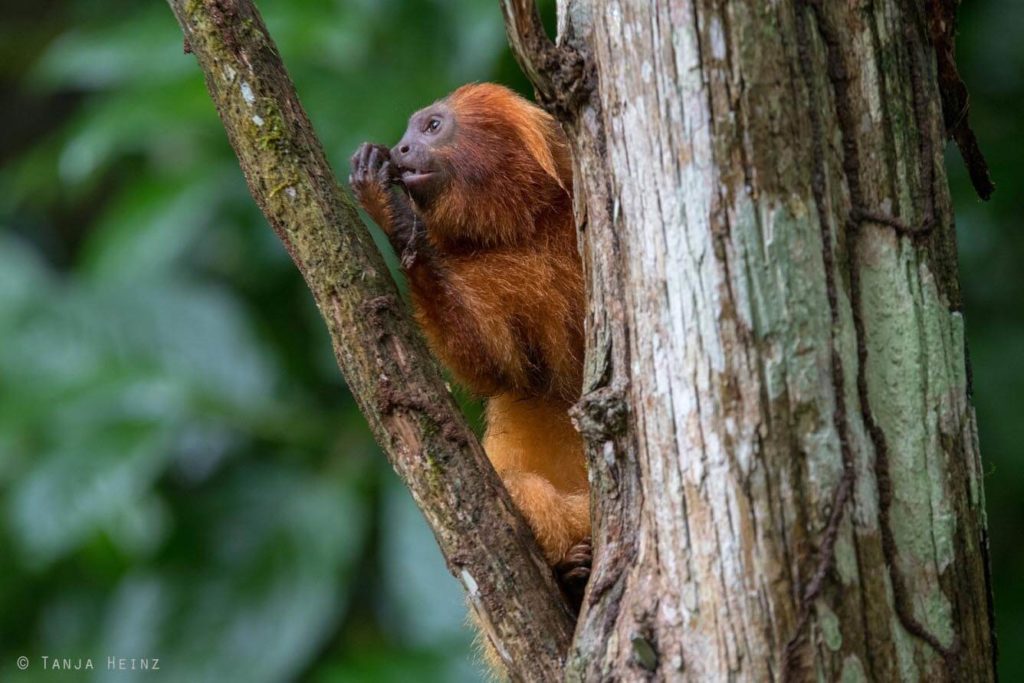The lush landscape of Brazil’s Atlantic Forest, once a sprawling haven for biodiversity, has witnessed a heartbreaking tale of deforestation. In the midst of this environmental crisis, a glimmer of hope emerges as young conservationists in Rio de Janeiro band together to create green corridors, offering a lifeline for the endangered golden lion tamarin. In this article, we delve into the significance of green corridors, the impact of deforestation, and the tireless efforts to secure a future for one of Brazil’s most iconic species.
The Golden Lion Tamarin’s Battle for Survival
The golden lion tamarin, with its copper-colored fur and distinctive silken mane, is a symbol of Brazil’s rich biodiversity. However, rampant deforestation has pushed this species to the brink of extinction. With fewer than 5,000 individuals remaining, the need for urgent conservation measures is undeniable. The Golden Lion Tamarin Association (AMLD) has taken up the challenge to reverse the grim fate of these monkeys.
Planting the Seeds of Change
Under the scorching sun in Rio de Janeiro’s rural interior, a group of young environmentalists recently undertook the crucial task of planting a green corridor. This corridor, formed by 300 tree seedlings, aims to reconnect two fragments of forest that were once torn down for cattle pasture. The land, once bare and dry, is now becoming a safe passageway for the golden lion tamarin, fostering the expansion of their habitat.
Luís Paulo Ferraz, the executive director of AMLD, emphasizes the critical role of these green corridors. He explains that the monkeys face challenges in crossing open land, as the fear of predators such as big cats prevents them from moving freely. Green corridors serve as bridges, ensuring genetic diversity by preventing inbreeding within the tamarin population.
Historical Echoes: Darwin’s Legacy in Brazil’s Forests
As the Green Corridor project unfolds, it draws the attention of prominent figures such as Sarah Darwin, the great-great-granddaughter of Charles Darwin. Darwin, renowned for his theory of evolution, had a transformative experience in the Brazilian Mata Atlantica forest nearly 200 years ago. Sarah Darwin, along with a group of young naturalists retracing Darwin’s expedition, applauds the efforts to preserve the forest’s astonishing biodiversity.
Deforestation’s Toll on Brazil’s Atlantic Forest
The once-vast Atlantic Forest biome, covering 133 million hectares along Brazil’s coast, has shrunk to less than 15% of its original size. In the specific region inhabited by golden lion tamarins, deforestation has reduced the forest to a mere 2% of its former expanse. Early drivers of deforestation included sugar cane and coffee plantations, followed by urban development and cattle pastures.
The consequences of these actions reverberate through time. In the 1970s, with only 200 golden lion tamarins remaining, scientists initiated conservation efforts. The species became a symbol of wildlife preservation in Brazil, even gracing the country’s 20-real bill.
Conservation in Action: Reforesting the Region
To combat the devastating impact of deforestation, AMLD has been acquiring land from farmers and cattle ranch owners. Through a meticulous process, they reforest the acquired parcels, one patch at a time. The journey is arduous, demanding substantial investment and consistent maintenance, particularly in the initial years. However, the rewards are tangible.
Since their first acquisition of 137 hectares in 2018, followed by another 180 hectares in November, AMLD has witnessed the transformation of barren hills into vibrant green landscapes. Night vision cameras capture the resurgence of diverse animal species, signifying the ecological revival of the region.
The Road Ahead: From Yellow Fever Setbacks to Population Growth
Despite facing challenges like a significant drop in the population due to yellow fever in 2018, the golden lion tamarin population is on the rise. The latest survey conducted by AMLD, published earlier this year, indicates a population of around 4,800 individuals. This resurgence is a testament to the success of dedicated conservation efforts and the positive impact of green corridors on the species’ survival.
Challenges and Solutions: A Continuous Effort
While the progress made by AMLD is commendable, challenges persist on the path to restoring Brazil’s Atlantic Forest. The slow and expensive nature of reforestation demands ongoing financial support and commitment. Collaborative efforts involving government agencies, private sectors, and international organizations are crucial for scaling up these initiatives and addressing the root causes of deforestation.
Climate change poses an additional threat to the delicate balance of ecosystems. As temperatures rise and weather patterns shift, adapting conservation strategies becomes imperative. Integrating climate resilience into reforestation plans and wildlife management ensures that the restored habitats remain robust and capable of withstanding environmental changes.
Global Implications and Inspiration
The story of green corridors and the golden lion tamarin resonates beyond the borders of Brazil. It serves as an inspiration for similar initiatives worldwide, encouraging the adoption of sustainable practices and the restoration of habitats for endangered species. The global community can draw valuable lessons from AMLD’s journey, emphasizing the need for collective action to address the pressing challenges of biodiversity loss and deforestation.
International collaboration, knowledge sharing, and the exchange of best practices are essential components of a united front against the ongoing ecological crisis. Governments, non-governmental organizations, and concerned individuals can contribute to the preservation of biodiversity by supporting and implementing initiatives that mirror the success of the Green Corridor project in Brazil.
Conclusion: A Ray of Hope in the Canopy
In conclusion, the story of Brazil’s golden lion, tamarin, reflects the broader narrative of environmental conservation. The creation of green corridors stands as a beacon of hope, offering a chance for the golden lion tamarin to thrive once again. As we witness the transformation of deforested lands into flourishing habitats, it becomes clear that human intervention, guided by dedication and scientific understanding, can reverse the course of ecological decline. The green corridors not only reconnect fragmented forests but also bridge the gap between the mistakes of the past and a sustainable future for Brazil’s diverse ecosystems.

